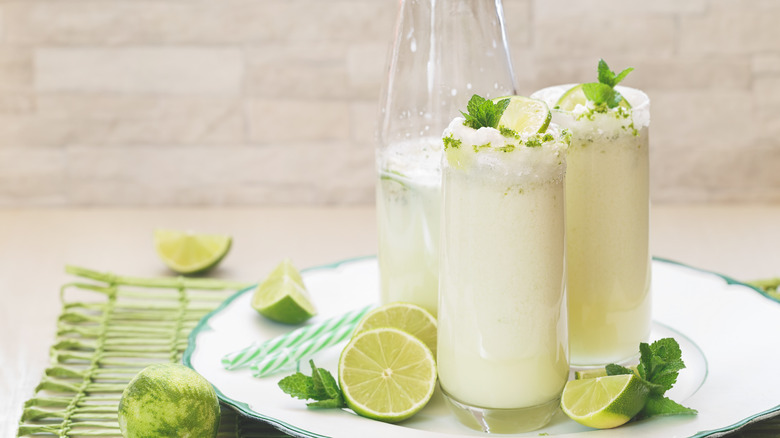What Is Brazilian Lemonade And Why Is It Made With Limes?
Brazilian lemonade has emerged as the drink of the summer, and we have to agree that it deserves its place. The first thing to clear up is that Brazilian lemonade isn't made from lemons but from limes. This lemonade is quite different from the classic lemonade or limeade we may be accustomed to; it has a frothy element to it that comes from the addition of condensed milk. With a satisfying balance of richness and tartness, it's perfect for anyone who enjoys creamy desserts or lemonades, for that matter.
Not only does Brazilian lemonade contain this special ingredient, but it also uses whole limes — pith, peel, and all. The whole limes are blended with water and ice to create the base of the drink. There's no need to fret, though, as the condensed milk and lime juice mask any bitterness coming from the peel. Plus, the unwanted chunks are strained out before you drink.
Why is it called Brazilian lemonade?
The reason why Brazilian lemonade is called a lemonade and not a limeade is due to some simple translation differences. In Portuguese, limão is the term for lime, so it's preferred to call the drink limonada. Limonada translated to English, however, means simply lemonade. Limonada generally serves as a broad term for any lime juice or lemon juice, hence the confusion with the English name, Brazilian lemonade.
Another source of confusion about this drink is its other name, Swiss lemonade, or as Brazilians like to call it, limonada suíça. There are several theories on how it got its name: Most believe it's due to the addition of condensed milk, which used to be a Swiss import. Others believe it's "suíça" because, supposedly, the owner of a restaurant who created it was of Swiss origin. Lastly, there is a rumor that the drink was made by a hospitality school located in Switzerland.
How to make Brazilian lemonade
The first step to making Brazilian lemonade is to have clean limes on hand. Make sure to scrub those limes clean since you'll be blending the entire fruit. You could even slice them into quarters for an easier pulse. The most important tip is to blend for a short amount of time — if you blend the pith for more than 10 seconds or so, the drink will taste bitter. Using the whole fruit, especially the zest, adds more citrus flavor to your lemonade. The lime wedges should be pulsed in a smoothie blender with plenty of water to make the lemonade base; afterward, add some ice and condensed milk and continue to blend.
Don't worry about the chunks of lime pith or pulp, you'll be straining the whole thing through a fine mesh sieve. The consistency of the finished beverage should resemble something between a regular lemonade and a light slush drink, and you can add extra ice and a lime garnish for a boost of chill. This icy and creamy delight is arguably easier to make than the standard lemonade — pulsing the whole lime rather than juicing each wedge means less time prepping and more time sipping, making this an easy summer concoction to whip up on the fly.


